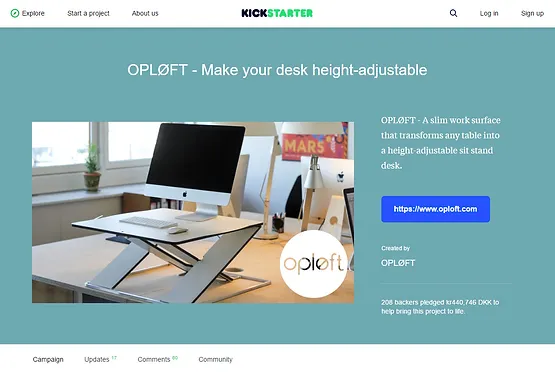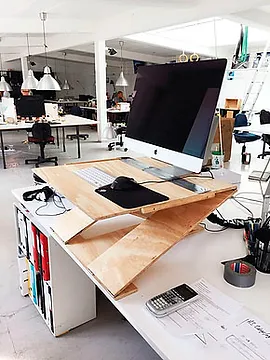The office was tense with excitement, when our campaign went online on the 20. April 2016. Huge effort was put into preparing the campaign in the hope of improving the odds for succeeding, but it still felt like a leap of faith: In one months enough people had to find and like OPLØFT so much, that they were willing to put down $350 for it. If we didn’t raise the $60.000 we were asking for, OPLØFT wouldn’t succeed.
About the series: We knew very little about crowdfunding, when we decided to crowdfund our height-adjustable desk OPLØFT in the beginning of 2016. The experience was intense, but in the end we got the $60.000 we needed to start production. The journey has taught us a great deal, and in this series we want to share our insights, do’s and dont’s, so you can learn from our mistakes.
Crowdfunding has become a serious investment model over the past decade, and in 2015 “Reward and Donation Crowdfunding” like Kickstarter accounted for an estimated $5.5 billion. It has huge potential but crowdfunding isn’t just mindlessly filling out the blanks in the campaign-application and watch the dollars roll in. Crowdfunding is hard!
325.000 projects has been submitted to Kickstarter since its launch in 2009, but only 115.000 has been successfully funded. 2 in 3 fail. We knew that when we decided to crowdfund OPLØFT in the beginning of 2016, and we also knew that the number of successful projects fell to 15.400, when we asked for $60.000. But we nevertheless felt crowdfunding was the right path for OPLØFT.
Why should we choose crowdfunding?
In the search for a better height adjustable desk we ended up making our own. After months of development and testing we were convinced we had a strong product, we just needed to get it to market. But before turning to crowdfunding, we asked ourselves the crucial question: Is there a better way to market?

<<Early prototype of OPLØFT made of plywood. It wasn’t pretty, but it proved the concept.
As an inventing company a licensing deal seemed like the obvious way to go, but OPLØFT was still in the prototype-phase, and we wanted decent proof-of-concept before licensing the project.
Instead of exiting early we decided we wanted to take the product further on our own. OPLØFT was our first consumer product, and as manufacturing and distribution isn’t our core competencies, we teamed up with some strong partners who should help take care of production.
With the production strategy lined up we needed distribution, and that way Kickstarter started to look more like the perfect fit: We could test the market, get distribution for the first run of OPLØFT while getting the funds to finalize OPLØFT and getting production set up.
We discussed a few other strategies to get it to market, but after our initial research and analysis in February – mainly looking at similar products who had failed or succeeded on Kickstarter – we decided Kickstarter was the way to go.
Preparation is key
If we were to crowdfund OPLØFT we wanted to set aside the res sources needed to do it properly. According to the crowdfunding marketing company Krowdster, the #1 reason why campaigns fail, is their lack of preparation. And failing on Kickstarter means getting nothing in return for the money and precious time you’ve poured into your campaign.
For that reason we sat aside two month before campaign-launch in order to get prepared. We had to figure out our exact funding goal, how to handle customs, setting up the campaign, figure out how to market it – and a thousand other things while simultaneously preparing OPLØFT for production.
In order to get ready in just two months we also paid a production company to help us make the campaign video and we hired a SoMe-guy and a journalist to help us get the marketing right. And even though no one in the team was exactly crowdfunding-experts, we started preparing for the Kickstarter-launch in April.
In #2 of the series, we will tell you about the production of our video – a key element in every campaign. If you have any questions regarding video production, feel free to leave a comment or contact Sebastian at sk@lolle-nielsen.com. The same goes for this post – ask anything you want, and we will add it to the Q&A-section below.

Q&A Why crowdfunding?
It was our first consumer product, and we wanted to test the marked while getting funds for finalizing the product.
Choosing platform – why Kickstarter?
It’s the biggest platform, and as it has a screening process the projects seems to be taken more seriously. Projects in the “Product Design”-category seem to thrive on Kickstarter, while other project might do better elsewhere.
Indiegogo has its perks as well – mainly the flexible funding model, where you can choose to keep the money even though you don’t get the project 100% backed. If our project wasn’t accepted on Kickstarter, it would have been our second choice.
We also looked into using the Danish platform Booomerang.dk, but we really wanted to test our product on a global scale.
We discussed using an Asian platform as well as Kickstarter, but decided not to, as we didn’t want to run two campaigns simultaneously
There’s also a difference in the fees each platform collects as well as payment fees, and at 5-10% rates this isn’t something you should ignore. But for us they turned out to be similar no matter the platform.
Why $60.000?
This was a really tricky one! It’s hard to determine how much you will need to spend on unforeseen issues (they are always there!) before you finish production. At the same time it’s hard to know how much you’ll exactly earn: International shipping means different customs duties, you don’t know which rewards-tiers will sell the best – and remember the platform fee at 5-10%.
It’s really a balance between: You get a bigger chance of succeeding and trending with a lower amount, but on the other hand you want to make sure you don’t run out of money.
We went with a convervative “belt and braces”-approach to be 110% sure we didn’t run out of funds, but in hindsigt we could have set a lower and more risky goal.

